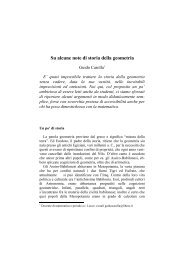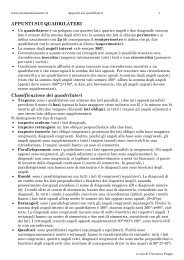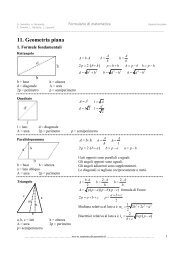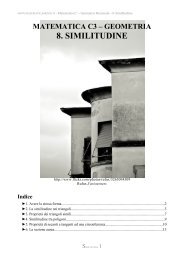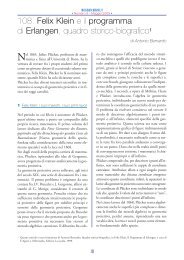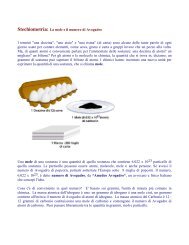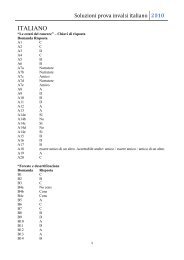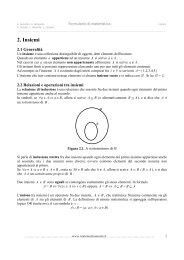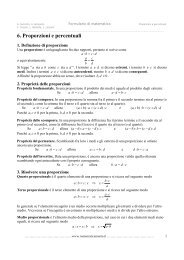Elementi di meccanica dei materiali e metallurgia - Matematicamente.it
Elementi di meccanica dei materiali e metallurgia - Matematicamente.it
Elementi di meccanica dei materiali e metallurgia - Matematicamente.it
You also want an ePaper? Increase the reach of your titles
YUMPU automatically turns print PDFs into web optimized ePapers that Google loves.
“<strong>Elementi</strong> <strong>di</strong> <strong>meccanica</strong> <strong>dei</strong> <strong>materiali</strong> e <strong>metallurgia</strong>” <strong>di</strong> Matteo Puzzle – matematicare@hotmail.com<br />
Dove il prodotto tra l’area e la lunghezza esprime il volume:<br />
V = A⋅ L<br />
Quin<strong>di</strong>, sost<strong>it</strong>u<strong>it</strong>a nella [4.1.3] l’espressione del lavoro <strong>di</strong>viene:<br />
δW = ( σY⋅ V) dε<br />
[4.1.4]<br />
Per una variazione fin<strong>it</strong>a della deformazione si ha:<br />
ε1<br />
∫ ( σ Y ) dε<br />
[4.1.5]<br />
W = ⋅V<br />
ε0<br />
E con il volume costante, si ottiene l’energia per un<strong>it</strong>à <strong>di</strong> volume, cioè<br />
W<br />
V<br />
3<br />
⎡ ⎤<br />
⎣J/ m⎦<br />
:<br />
ε1<br />
= ∫ σ Y dε<br />
[4.1.6]<br />
ε0<br />
Da notarsi l’uso del <strong>di</strong>fferenziale non esatto δ , in quanto la quant<strong>it</strong>à infin<strong>it</strong>esima <strong>di</strong> lavoro<br />
non è il <strong>di</strong>fferenziale <strong>di</strong> una funzione (ad esempio <strong>di</strong> coor<strong>di</strong>nate termo<strong>di</strong>namiche PVT),<br />
bensì un <strong>di</strong>fferenziale non esatto; infatti nel campo plastico un provino sottoposto a<br />
trazione, una volta scaricato, non r<strong>it</strong>ornerà alla configurazione iniziale (vi è una<br />
deformazione permanente), ed anche in campo elastico vi è sempre una piccolissima<br />
deformazione residua.<br />
Se il carico esterno viene applicato<br />
lentamente, la trasformazione è<br />
essenzialmente quasi statica; si può<br />
quin<strong>di</strong> utilizzare un’equazione <strong>di</strong> stato per<br />
esprimere σ Y in funzione <strong>di</strong> ε , così da<br />
poter eseguire l’integrazione. La figura 4.1<br />
mostra una tipica curva sforzo –<br />
deformazione per un metallo in tensione. Il<br />
lavoro per un<strong>it</strong>à <strong>di</strong> volume dell’elemento<br />
considerato a volume costante deformato<br />
per la tensione da ε 0 a ε 1 è rappresentato<br />
dall’area sotto il tratto <strong>di</strong> curva compreso<br />
tra i punti σ 0 e σ 1.<br />
L’andamento rettilineo<br />
del <strong>di</strong>agramma rappresenta la legge <strong>di</strong><br />
Hooke. Figura 4.1<br />
Considerando ε reale, quin<strong>di</strong> ε reale , cioè la deformazione rifer<strong>it</strong>a alla effettiva variazione<br />
della lunghezza e della sezione dell’elemento sottoposto allo sforzo σ Y , si ottiene:<br />
dL L<br />
ε reale = ε = = = + ε<br />
ε0<br />
L0<br />
L L<br />
ε1<br />
L1<br />
1<br />
∫ d ∫ ln ln ( 1 )<br />
[4.1.7]<br />
0<br />
L’espressione [4.1.6] può scriversi come:<br />
W<br />
=<br />
L1<br />
dL<br />
σ ⋅<br />
[4.1.8]<br />
∫<br />
Y<br />
V L0<br />
L<br />
Sviluppando:<br />
W dL L<br />
= σ ⋅ = σ ⋅ = σ ⋅ +<br />
V L L<br />
L1<br />
1<br />
∫ ln ln ( 1 ε )<br />
[4.1.9]<br />
Y<br />
L<br />
Y Y<br />
0<br />
0<br />
Quest’ultima equazione, spesso nota come l’espressione del lavoro, fornisce una<br />
ragionevole approssimazione per un metallo il quale è stato lavorato duramente prima<br />
dell’allungamento a trazione, così che σ y (tensione <strong>di</strong> snervamento) non varia<br />
eccessivamente nel processo. Ciò è meno atten<strong>di</strong>bile per un materiale ricotto, in cui il<br />
rapido incremento con la tensione (per cui è preferibile usare l’espressione [4.1.6] o<br />
[4.1.8]) integra la curva sforzo – deformazione graficamente o numericamente (infatti il<br />
32




